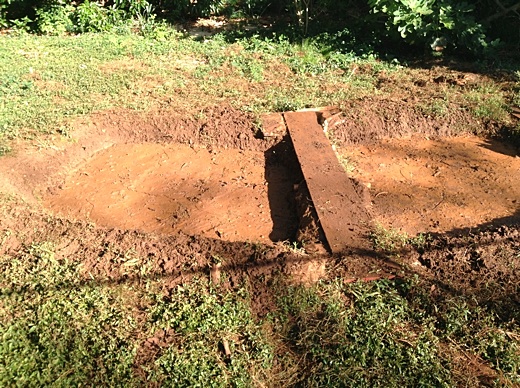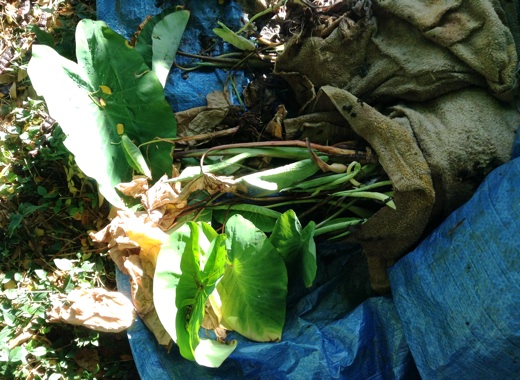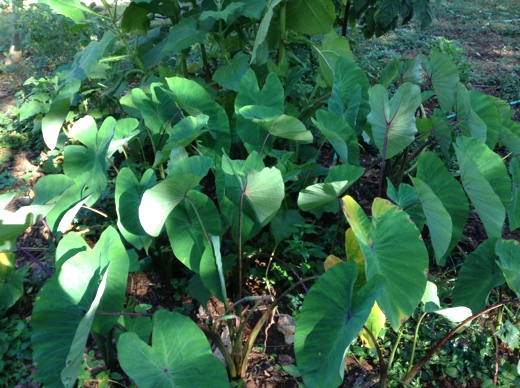SUBHEAD: On Kauai it appears a beautiful morning to work on our valley garden. But don't linger too long in that midday sun.
By Juan Wilson on 21 June 2013 for Island Breath -
(http://islandbreath.blogspot.com/2013/06/summer-solstice-2013.html)

Image above: Dryland taro beds in Hanapepe Valley, ready to be recharged and replanted. Photo by Juan Wilson.
We found we are increasingly dependent on three year round vegetable crops that, once set up, are relatively easy to maintain. They are (in increasing order of effort to convert into calories): chayote, cassava and taro. Each can be an anchor for a dinner, whether vegetarian, or with meat or fish.
Today is a bit of an exception to the normally low maintenance of of our taro. We're recharging two of our five beds of dryland Chinese taro. It's a bit of work for someone on their sixties.
A week ago we wet the beds to softness and pulled the taro from two beds. We laid the whole plants aligned like soldiers on some dampened towels, on top of a small tarp, in the shade of a dense clump of heliconia. We laid a damp towels on top of the taro and folded the tarp over them with just the tops peeping out. Every other day or so we'd check their dampness and spritz them a bit if they were drying.

Image above: Chinese taro huli in a cool, moist, shaded spot ready to be replanted. Photo by Juan Wilson.
We've found you can keep taro out of the ground and healthy for a prolonged time, even if you've harvested the corm (root) and topped off all but the newest leaf bud. This is a form for replanting harvested taro called huli. Huli can lay for many weeks in a cool, shady, moist spot.
We didn't harvest the corm but wanted to rid the beds of weeds. Being dryland taro they are not kept flooded and consequently get choked with weeds after several months unless an extra effort is made to keep the pests out.
What we do is occasionally pull the plants, remove the weeds, turn over and amend the soil. In the past that has often meant adding sand from a brackish stream before it meets the ocean. This time we'll be adding a mix of chicken manure and sawdust from a friend who has a egg farm. We also have some spirulina a friend has contributed.
In addiditon, this time we will be adding some soil as well. This morning we are heading off to Kauai Nursery near Puhi for a cubic yard of their 50-50 mix (50% soil and 50% compost) They charge $50 a yard (a small pickup can carry about two-thirds of that).We hope to have the truck unloaded before the sun gets too high in the sky.

Image above: One of our taro beds that will be last to be harvested. Photo by Juan Wilson.
On Kauai it appears a beautiful morning to work on our valley garden. But don't linger too long in that midday sun. At this the time of year, and with the recent heightened solar activity it is pretty brutal in the full sun at noon at this latitude. hats, shirts and eye protection are in order.
Probably in the late afternoon, when the sun is shaded by the western wall of Hanapepe Valley, we'll replant the taro and let is settle into the recharged soil in the cool of the evening.
Have a delightful sunset this Summer Solstice.
See also:
Ea O Ka Aina: Summer Solstice 2012 6/20/12
Ea O Ka Aina: Winter Solstice 2011 12/21/11
Ea O Ka Aina: Summer Solstice 2010 6/21/10
Ea O Ka Aina: Winter Solstice 2009 12/21/09
Ea O Ka Aina: Winter Solstice 2008 12/21/08.
By Juan Wilson on 21 June 2013 for Island Breath -
(http://islandbreath.blogspot.com/2013/06/summer-solstice-2013.html)

Image above: Dryland taro beds in Hanapepe Valley, ready to be recharged and replanted. Photo by Juan Wilson.
We found we are increasingly dependent on three year round vegetable crops that, once set up, are relatively easy to maintain. They are (in increasing order of effort to convert into calories): chayote, cassava and taro. Each can be an anchor for a dinner, whether vegetarian, or with meat or fish.
Today is a bit of an exception to the normally low maintenance of of our taro. We're recharging two of our five beds of dryland Chinese taro. It's a bit of work for someone on their sixties.
A week ago we wet the beds to softness and pulled the taro from two beds. We laid the whole plants aligned like soldiers on some dampened towels, on top of a small tarp, in the shade of a dense clump of heliconia. We laid a damp towels on top of the taro and folded the tarp over them with just the tops peeping out. Every other day or so we'd check their dampness and spritz them a bit if they were drying.

Image above: Chinese taro huli in a cool, moist, shaded spot ready to be replanted. Photo by Juan Wilson.
We've found you can keep taro out of the ground and healthy for a prolonged time, even if you've harvested the corm (root) and topped off all but the newest leaf bud. This is a form for replanting harvested taro called huli. Huli can lay for many weeks in a cool, shady, moist spot.
We didn't harvest the corm but wanted to rid the beds of weeds. Being dryland taro they are not kept flooded and consequently get choked with weeds after several months unless an extra effort is made to keep the pests out.
What we do is occasionally pull the plants, remove the weeds, turn over and amend the soil. In the past that has often meant adding sand from a brackish stream before it meets the ocean. This time we'll be adding a mix of chicken manure and sawdust from a friend who has a egg farm. We also have some spirulina a friend has contributed.
In addiditon, this time we will be adding some soil as well. This morning we are heading off to Kauai Nursery near Puhi for a cubic yard of their 50-50 mix (50% soil and 50% compost) They charge $50 a yard (a small pickup can carry about two-thirds of that).We hope to have the truck unloaded before the sun gets too high in the sky.

Image above: One of our taro beds that will be last to be harvested. Photo by Juan Wilson.
On Kauai it appears a beautiful morning to work on our valley garden. But don't linger too long in that midday sun. At this the time of year, and with the recent heightened solar activity it is pretty brutal in the full sun at noon at this latitude. hats, shirts and eye protection are in order.
Probably in the late afternoon, when the sun is shaded by the western wall of Hanapepe Valley, we'll replant the taro and let is settle into the recharged soil in the cool of the evening.
Have a delightful sunset this Summer Solstice.
See also:
Ea O Ka Aina: Summer Solstice 2012 6/20/12
Ea O Ka Aina: Winter Solstice 2011 12/21/11
Ea O Ka Aina: Summer Solstice 2010 6/21/10
Ea O Ka Aina: Winter Solstice 2009 12/21/09
Ea O Ka Aina: Winter Solstice 2008 12/21/08.
1 comment :
Some advice, learn about "green manureing", and cover crops, these create a food source for the current crop, or next crop. For example peanuts, these grow very easily, and cover the ground and discourage weeds, and you benefit by having this leguminous crop both increase soil fertility, and you get peanuts too. Come fall harvest the peanuts, and when you might plant your tomatoes, or? other fall crop, the soil will be richer. Green manure crops increase soil fertility in a natural way. use the residue for mulch, Where as manures may upset the amino acid balance of your crop plant, and may cause the plants to attract more harmful insects because the plants grow so richly. Companion plant with stuff like soy beans, and other legumes (non GMA kind, if you can find them.) maybe UH seed lab. Happy farming!
Post a Comment